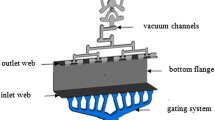Abstract
In this work, the failure characteristics of a die-casting die manufactured from conventional hot-worked steel (SKD61) were investigated experimentally. A die with heat-checking failure on its cavity due to high-pressure die casting was employed. Apparently, the microstructural characteristics of the die around the regions exhibiting heat checking were unaltered. However, the hardness values decreased slightly because of the die heating via the injection of molten aluminum alloy, which is the tempering-like effect. Hydrogen was detected in the die around the regions with heat checking, which can slightly reduce the tensile fracture strain, i.e., hydrogen embrittlement (HE). The extent of HE was sensitive to the loading speed, particularly to a low loading speed. When heated to 450 °C, hydrogen gas was detected in a commercial die lubricant, which may lead to hydrogen infiltration in the die. This paper discusses the details pertaining to hydrogen penetration and die failure mechanisms.












Similar content being viewed by others
References
S. Otarawanna, H.I. Laukli, C.M. Gourlay, A.K. Dahle, Feeding mechanisms in high-pressure die castings. Metall. Mater. Trans. A 41, 1836–1846 (2010)
R.W. Simons, T.R. Mohr, Lessons learned heat treating high pressure die casting tools. NADCA Trans. T17–033, 1–13 (2017)
S. Sivertsen, R. Oliver, K. Anantha, G. Maistro, Key properties of die material needed for structural aluminum-high pressure die casting (HPDC). NADCA Trans. T19–111, 1–15 (2019)
R. Shivpuri, M. Yu, K. Venkatesan, Y.-L. Chu, A study of erosion in die casting dies by a multiple Pin accelerated erosion test. ASM Int. 4, 145–153 (1995)
N. Umemori, M. Kawano, T. Masuda, evaluation of heat checking of molds through flow and solidification simulation. NADCA Trans. T18–012, 1–8 (2018)
Y. Tamura, T. Okuno, New hot working tool steels for die casting. Imono 62, 1008–1014 (1990)
D. Long, A. Thornhill, C. Armstrong, D. Watson, Stress correlation between instrumentation and simulation analysis of the die for high pressure die casting. Inter. Metalcast. 7, 27–41 (2013). https://doi.org/10.1007/BF03355551
S. Müller, K. Dilger, A. Müller, F. Rothe, K. Droder, An initial study of a lightweight die casting die using a modular design approach. Inter. Metalcast. 12, 870–883 (2018). https://doi.org/10.1007/s40962-018-0218-3
A. Long, D. Thornhill, C. Armstrong, D. Watson, Predicting die life from die temperature for high pressure dies casting aluminium alloy. Appl. Therm. Eng. 44, 100–107 (2012)
C. Chen, Y. Wang, H. Ou, Y. He, X. Tang, A review on remanufacture of dies and moulds. J. Clean. Product. 64, 13–23 (2014)
C.M.D. Starling, J.R.T. Branco, Thermal fatigue of hot work tool steel with hard coatings. Thin Solid Films 308–309, 436–442 (1997)
R. Shivpuri, Y.-L. Chu, K. Venkatesan, J.R. Conrad, K. Sridharan, M. Shamim, R.P. Fetherston, An evaluation of metallic coatings for erosive wear resistance in die casting applications. Wear 192, 49–55 (1996)
A.J. Norwood, P.M. Dickens, R.C. Soar, R.A. Harris, Surface temperature of tools during the high-pressure die casting of aluminium. J. Eng. Manufact. 221(B), 1659–1664 (2007)
V.K. Venkatasamy, A. Thesis, Analysis of In-Cavity Thermal and Pressure Characteristics in Aluminum Alloy Die Casting (The Ohio State University, Ohio, 1996)
A. Srivastava, V. Joshi, R. Shivpuri, Numerical models and their validity in the prediction of heat checking in die casting tooling, in 6th Int. Tool. Conf.
M. Muhic, J. Tusek, F. Kosel, D. Klobcar, M. Pleterski, Thermal fatigue cracking of die casting dies. Metabk 49, 9–12 (2010)
A. Srivastava, V. Joshi, R. Shivpuri, R. Bhattacharya, S. Dixit, A multilayer coating architecture to reduce heat checking of die surfaces. Surf. Coat. Tech. 163–164, 631–636 (2003)
K.-D. Fuchs, Hot-work tool steels with improved properties for die casting applications, in 6th Int. Tool. Conf.
S. Koshiba, T. Kunou, An adaptability of 5%Cr-containing steel for heat-resisting applications. Tetsu-to-Hagane 44, 142–145 (1958)
B. Navinšek, P. Panjan, I. Milošev, Industrial applications of CrN (PVD) coatings, deposited at high and low temperatures. Surf. Coat. Technol. 97, 182–191 (1997)
L. Petan, J.L. Ocaña, J. Porro, J. Grum, Potential improvements of mechanical properties of maraging steels after laser shock peening (LSP). Int. J. Peen. Sci. Technol. 1, 61–73 (2018)
Patent: JP2003253290A (2002). https://www.city.okayama.jp/kurashi/0000016094.html.
Report by Wacker Asahikasei Silicone Co.,Ltd., P431001, ver.002, March 12, 2012. http://www.aws-silicone.com/dcms_media/image/partingagent.pdf
M. Okayasu, L. Yang, Influence of microstructure on the mechanical properties and hydrogen embrittlement characteristics of 1,800 MPa grade hot-stamped 22MnB5 steel. J. Mater. Sci. 54, 5061–5073 (2019)
K. Takai, R. Watanuki, Hydrogen in trapping states innocuous to environmental degradation of high-strength steels. ISIJ Int. 43, 520–528 (2003)
Y. Murakami, S. Matsuoka, Effect of hydrogen on fatigue crack growth of metals. Eng. Fract. Mech. 77, 1926–1940 (2010)
Y. Li, Z. Yang, S. Li, Y. Liu, S. Chen, W. Hui, Y. Weng, Effect of hydrogen on fatigue strength of high-strength steels in the VHCF regime. Adv. Eng. Mater. 11, 561–567 (2009)
M. Okayasu, R. Arai, T. Senuma, The effects of the microstructural characteristics of Fe–0.33 C–1.2 Mn–xNb–xMo steels on hydrogen embrittlement fracture. Int. J. Fract. 231, 257–274 (2021)
M. Okayasu, J. Motojima, Microstructure-dependent hydrogen diffusion and trapping in high-tensile steel. Mater. Sci. Eng. A 790, 139418 (2020)
Acknowledgements
This work was financially supported by SUZUKI FOUNDATION, and the authors would like to acknowledge our mentors from SUZUKI MOTOR CORPORATION (Mr. Shogo Komura, Mr. Osahiko Horii, Mr. Takeshi Aoki, Ms. Arisa Osugi, and Mr. Kosuke Kakinoki) for their scientific advice. Die-casting die was provided by KYOWA CASTING Co., Ltd (Mr. Masaki Touda).
Author information
Authors and Affiliations
Corresponding author
Additional information
Publisher's Note
Springer Nature remains neutral with regard to jurisdictional claims in published maps and institutional affiliations.
Rights and permissions
Springer Nature or its licensor (e.g. a society or other partner) holds exclusive rights to this article under a publishing agreement with the author(s) or other rightsholder(s); author self-archiving of the accepted manuscript version of this article is solely governed by the terms of such publishing agreement and applicable law.
About this article
Cite this article
Okayasu, M., Shigematsu, K. Hydrogen Embrittlement Characteristics of a Die-Casting Die after a High-Pressure Die-Casting Operation. Inter Metalcast 18, 810–820 (2024). https://doi.org/10.1007/s40962-023-01081-y
Received:
Accepted:
Published:
Issue Date:
DOI: https://doi.org/10.1007/s40962-023-01081-y




